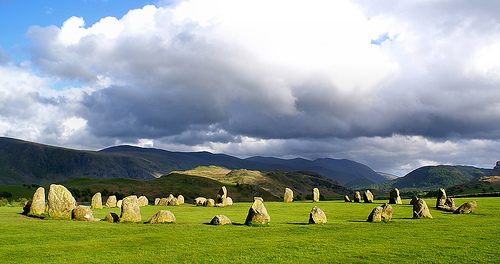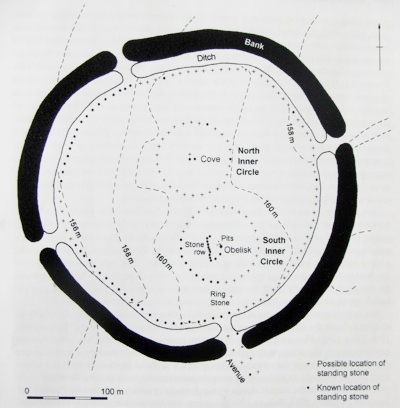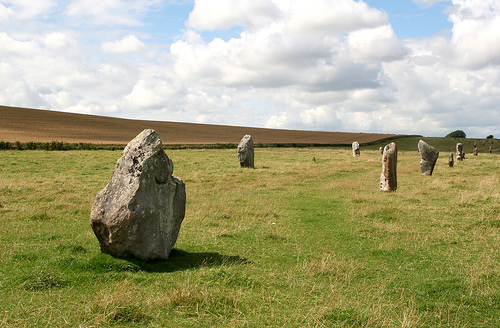

Location: Wiltshire Map
Info: Green St
Tel. 01672 539250
Open: daily
Constructed: 2600 BC
Alexander Keiller Museum
Off High St.
Tel. 01672 538015
Open: daily
Closed: 24- 26 Dec

The Henge was created around 2600 to about 2500 BC. erected. It is
one of the great Neolithic henges, along with Marden, Durrington
Walls and Mount Pleasant (Dorchester), and may be associated with
the Grooved Ware.
From the 14th century the destruction of
the monument began on the instructions of the Christian church. Many
stones were then buried. According to a village legend, during such
a "stone burial" a bather was killed by a falling stone and buried
under it. In 1938 a skeleton was indeed discovered by archaeologist
Alexander Keiller, along with coins, a graver and a pair of very
well-preserved scissors that were a rarity at the time. Based on the
minting of the coins, the year of his death could be narrowed down
to 1320 at the earliest. The stone is also called "Barber Stone"
today and is a flat, narrow stone. However, a re-examination of the
skeleton in 1999 showed that it had no injuries to confirm that the
man had indeed been crushed by the 13-ton stone. It is therefore
assumed that the man had already died and was buried under the stone
by the villagers along with his belongings for reasons that are not
yet known.
In order to gain space for agriculture, more
stones were removed in the 17th and 18th centuries and used, for
example, to build houses. In order to destroy the very hard stones,
they were heated with fire and then doused with cold water. Along
the cracks caused by thermal stresses, the stones could be split and
dismantled with tools.
The scholar John Aubrey in 1648
identified the soil features and the large stones in the landscape
and in the village as a prehistoric stone circle, which he
attributed to Druids who lived about 2000 years after the stone
circles were built. The scholar William Stukeley referred to the
stone circle from 1720 as the sanctuary of the British Druids (
Temple of British Druids ).
Excavations were carried out by Alexander Keiller in the 1920s. In 1930 numerous stones were re-erected by the National Trust.
The geometry of the Avebury stone circle is far more advanced than
that of the other stone circles in Britain.
Of the original
154 megaliths (stones), 36 are still preserved today. Together with
the stone avenues, the complex consisted of about 600 megaliths. The
locations of the destroyed stones of the stone circles are marked
with concrete pillars. The destroyed avenues were only partially
restored.
Outer Great Stone Circle (c.2500 BC)
Circumference approx. 1200 m
diameter 427 m
Originally 98
stones were set up on a 6 m high mound of earth, 27 of which have
been preserved. The stones were 2.1 m to 5.5 m high and weighed up
to 40 tons.
They are anchored 15 to 60 cm deep in the ground. The
largest stone ("obelisk") was 5.5 m high and was overthrown and
destroyed in the 18th century.
Inner Small North Circle
(c.2600 BC)
approx. 98 m in diameter
four of the original 27
stones have been preserved.
Inner Small South Circle (c.2600
BC)
approx. 104 m in diameter
five of the original 29 stones
have been preserved.
The entire area is freely accessible. Also worth seeing are the Alexander Keiller Museum in the historic barn and the medieval village church, which also houses the tourist information. If you follow the narrow street along Steinallee in a southerly direction, you will reach a larger country road after a short drive. From there, turning right, West Kennet Long Barrow, Silbury Hill and Swallowhead Springs, the source of the Kennet, can be visited.

One of the aspects discussed concerns the conformation of the place:
tall and slender, or low and wide. This leads to numerous theories
relating to the importance of gender in Neolithic Britain with tall
stones considered 'male' and low stones 'female'. The stones have not
been worked in any way and may have been chosen due to their shape. Many
people have identified what they believe are artificial grooves in the
rock, some more convincing than others.
The human bones found by
Gray suggest some funerary use. Ancient worship, even on a large scale,
may have been one of the causes for the construction of the site,
together with male-female role rituals.
The surrounding area,
although it seems to enclose the whole complex, has no defensive
purposes, given that the moat is inside. Being a stone circle,
astronomical alignment is a common theory to explain the placement of
stones. Some minor theories refer to aliens, ley lines, crop circles and
the lost wisdom of the ancients.
Perhaps the strangest theory is
the one proposed by Ralph Ellis who suggests that Avebury looks like a
diagram of the Earth moving through space, complete with 23 degrees of
axial tilt.
As with Stonehenge, the lack of modern excavations
and reliable scientific dating makes it extremely difficult to study.
Much of the small village of Avebury is enclosed within the monument.
two local roads intersect within the site, and tourists can walk on the
earthworks.
The two stone avenues (Kennet Avenue and Beckhampton
Avenue) which meet at Avebury form the two sides of a triangle
designated by UNESCO as a World Heritage Site which includes The
Sanctuary, Windmill Hill, Silbury Hill and the West Kennet Long Barrow .
Avebury is seen as a spiritual center by many people who profess
paganism, wicca, druidism and Etenism, and for some it is even more
important than Stonehenge. Pagan festivals attract tourists, and the
summer solstice especially sees crowds of worshipers of all
denominations.
As with Stonehenge, however, access is limited.
Whilst Avebury circles are open to all, access is controlled through the
car park lock. Avebury has grown in importance in recent years, and
tourist accessibility is still under study by the Sacred Sites,
Contested Rites/Rights project.
The National Trust, which
protects the site (owned by English Heritage), also dialogues with the
pagan community, who use the site as a religious temple or as a place of
worship. This dialogue takes place through a forum. The project provides
guides to tourists who help communication between the pagans who
frequent the place and the tourists.
The area was used to film Children of the Stones (1976), a British
children's television drama.
Derek Jarman's silent short A Journey to
Avebury (1971) is set among the stones.
The stones were also featured
in a key moment in the 1998 comedy Still Crazy, starring Billy Connolly,
Stephen Rea, Jimmy Nail, Timothy Spall and Bill Nighy. The film also
shows a scene inside the Red Lion of Avebury.
It was shown on the
2005 TV show Seven Natural Wonders. In a scene from the short film
Lucifer Rising (1972) by Kenneth Anger there is a short fixed shot
between the stones of Avebury.
Catherine Fisher's 2005 novel
Darkhenge is set in and around Avebury.
The village of Avebury is
also mentioned, a few times, in the show The Lost World where one of the
protagonists tells of having lived there as a child and she remembers
playing between the monoliths and the fairy circles.
In Werner
Herzog's documentary Nomad: In the Footsteps of Bruce Chatwin (Nomad: In
the Footsteps of Bruce Chatwin), Avebury is visited by the director.